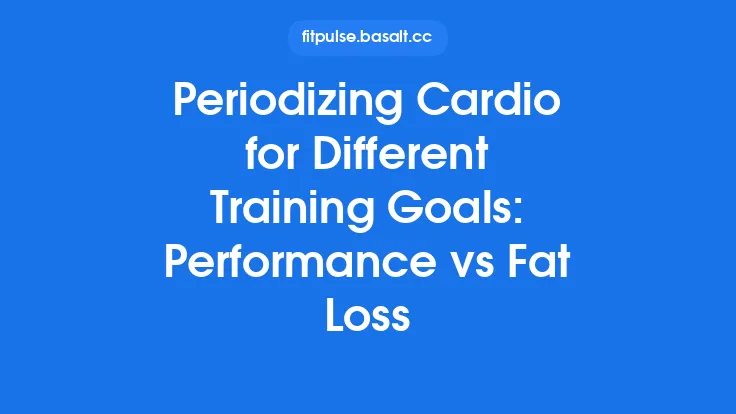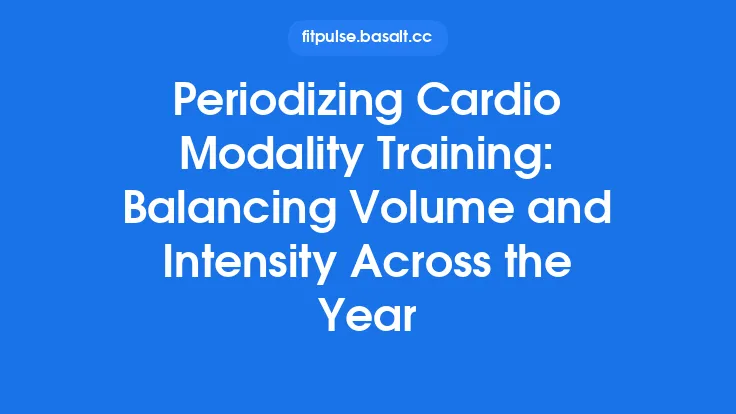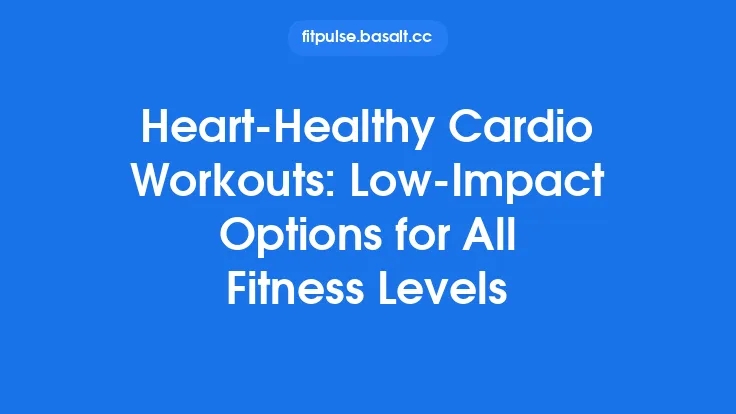Cardiovascular conditioning is one of the most adaptable components of a well‑rounded fitness program, yet many athletes and recreational exercisers treat it as a static, year‑round routine. In reality, the body’s response to aerobic stress is highly sensitive to the timing, volume, and intensity of the stimulus, as well as to the broader environmental context in which training occurs. By deliberately periodizing cardio workouts across the four seasons, you can harness natural fluctuations in daylight, temperature, and personal schedule to drive continuous physiological progress, avoid plateaus, and maintain long‑term motivation.
The core idea behind seasonal periodization is simple: structure your cardio training plan so that each season serves a specific purpose within an overarching annual cycle. This approach mirrors the periodization strategies long used by endurance athletes, strength coaches, and sports scientists, but it is tailored to the unique challenges and opportunities presented by the changing calendar. Below, we break down the principles, practical tools, and step‑by‑step methods you need to design a seamless, progressive cardio program that evolves with the seasons.
Understanding Seasonal Periodization
Seasonal periodization is a macro‑planning framework that aligns training phases with the natural rhythm of the year. Rather than viewing summer, autumn, winter, and spring as isolated blocks, think of them as interconnected stages that collectively shape your aerobic capacity, efficiency, and resilience.
| Season | Primary Training Focus | Typical Physiological Target |
|---|---|---|
| Spring | Rebuilding base endurance after winter downtime | Aerobic base (low‑to‑moderate intensity, high volume) |
| Summer | Enhancing speed and power while capitalizing on longer daylight | Threshold and interval work (moderate‑to‑high intensity, moderate volume) |
| Autumn | Consolidating gains and preparing for potential race‑specific demands | Race‑specific tempo and race‑pace sessions (high intensity, lower volume) |
| Winter | Maintaining fitness with reduced volume, focusing on recovery and cross‑training | Maintenance of VO₂max and lactate threshold, active recovery |
Each season’s focus is not rigid; rather, it provides a scaffold upon which you can layer individual workouts, micro‑cycles, and recovery strategies. By rotating emphasis—base, build, peak, transition—you create a systematic overload‑recovery pattern that drives adaptation while minimizing the risk of overtraining.
Macrocycle Planning: Aligning Annual Goals with Seasonal Demands
A macrocycle is the longest planning horizon, typically spanning 12 months. To construct a cardio macrocycle:
- Define Your Year‑End Objective
- Examples: completing a half‑marathon, improving a 5 km time, increasing weekly mileage, or simply enhancing overall cardiovascular health.
- Quantify the goal (e.g., “run 10 km in under 55 minutes”).
- Back‑Cast From the Goal Date
- Identify the peak performance window (often late summer or early autumn for many race calendars).
- Allocate the final 4–6 weeks before the target event for tapering and race‑specific sharpening.
- Segment the Year Into Seasonal Phases
- Preparation Phase (Late Winter/Early Spring): Light activity, mobility work, and low‑intensity cardio to re‑activate the system.
- Base Phase (Spring): High‑volume, low‑intensity sessions to develop mitochondrial density and capillary networks.
- Build Phase (Summer): Introduce tempo runs, interval training, and hill work to raise lactate threshold and VO₂max.
- Peak Phase (Autumn): Focus on race‑pace efforts, sharpening, and strategic taper.
- Transition Phase (Winter): Reduce volume, incorporate cross‑training, and emphasize active recovery.
- Assign Quantitative Targets to Each Phase
- Volume: Weekly mileage or minutes of cardio.
- Intensity Distribution: Percentage of time spent in each heart‑rate zone (e.g., 70 % Zone 2, 20 % Zone 3, 10 % Zone 4).
- Frequency: Number of cardio sessions per week.
By mapping these variables onto a calendar, you create a visual roadmap that clarifies when to push, when to hold steady, and when to recover.
Microcycle Adjustments: Tweaking Volume and Intensity
While macrocycles set the broad direction, microcycles (typically one‑week blocks) are where day‑to‑day decisions happen. A well‑designed microcycle respects the larger seasonal goal while allowing flexibility for life’s inevitable interruptions.
Key Microcycle Variables
| Variable | How to Manipulate | Seasonal Example |
|---|---|---|
| Session Length | Increase or decrease total minutes/kilometers. | Spring base weeks may feature 90‑minute long runs; summer interval weeks may cap at 45 minutes. |
| Intensity Zones | Shift the proportion of time spent in Zones 2–5. | Autumn peak weeks may allocate 30 % of time to Zone 4 (race pace). |
| Recovery Days | Insert easy or rest days strategically. | Winter transition weeks may have 3–4 rest days. |
| Cross‑Training Modality | Substitute a run with cycling, rowing, or swimming. | Summer heat may prompt a swim day to preserve volume without excessive thermal load. |
Sample Microcycle for a Summer Build Phase
| Day | Workout | Duration | Intensity |
|---|---|---|---|
| Mon | Easy run | 45 min | Zone 2 |
| Tue | Interval session (5 × 4 min @ VO₂max) | 60 min total | Zone 4‑5 |
| Wed | Rest or active mobility | — | — |
| Thu | Tempo run (20 min @ lactate threshold) | 50 min | Zone 3‑4 |
| Fri | Cross‑train (cycling) | 60 min | Zone 2‑3 |
| Sat | Long run (steady) | 90 min | Zone 2 |
| Sun | Recovery jog | 30 min | Zone 1‑2 |
Notice how the microcycle balances high‑intensity work with ample low‑intensity volume, aligning with the summer build objective of raising VO₂max and threshold while preserving aerobic base.
Modality Rotation: Leveraging Different Cardio Forms
Seasonal periodization is not limited to running; incorporating a variety of cardio modalities can enhance overall conditioning, reduce monotony, and provide unique physiological stimuli.
- Steady‑State Endurance (e.g., long jogs, moderate‑pace cycling)
- Primary driver of mitochondrial biogenesis and capillary growth.
- Ideal for spring base and winter maintenance phases.
- High‑Intensity Interval Training (HIIT) (e.g., sprint intervals, rowing sprints)
- Maximizes VO₂max improvements in a time‑efficient manner.
- Best placed in summer build and autumn peak phases.
- Tempo/Threshold Work (e.g., sustained 20‑minute runs at lactate threshold)
- Sharpens the ability to sustain higher percentages of VO₂max.
- Central to summer and autumn phases.
- Cross‑Training (e.g., swimming, elliptical, low‑impact cardio machines)
- Provides cardiovascular stimulus while reducing joint stress.
- Useful during winter transition or when weather limits outdoor options.
- Mixed‑Modality Circuits (e.g., rowing + bike intervals)
- Encourages neuromuscular coordination and metabolic flexibility.
- Can be introduced as a novelty stimulus during any phase to break plateaus.
By rotating modalities in line with seasonal goals, you exploit the principle of specificity while still promoting general adaptation—a balance that underpins long‑term progress.
Physiological Targets Across Seasons
Understanding the underlying adaptations you aim to elicit each season helps you select the right training variables.
| Season | Primary Adaptation | Key Training Variables |
|---|---|---|
| Spring (Base) | ↑ Mitochondrial density, ↑ capillary network, ↑ fat oxidation | High volume, low‑to‑moderate intensity, long continuous sessions |
| Summer (Build) | ↑ VO₂max, ↑ cardiac output, ↑ stroke volume | Shorter, high‑intensity intervals; moderate volume |
| Autumn (Peak) | ↑ Lactate threshold, ↑ economy at race pace, ↑ neuromuscular coordination | Tempo runs, race‑pace intervals, reduced volume |
| Winter (Transition) | ↑ Recovery capacity, ↑ active rest, ↑ cross‑modal endurance | Low volume, mixed modalities, emphasis on active recovery |
Each adaptation builds upon the previous one. For instance, a robust aerobic base from spring makes the high‑intensity work of summer more effective, while the threshold improvements of autumn translate into better performance during the transition phase.
Monitoring Progress and Making Data‑Driven Adjustments
Objective tracking is essential to ensure that seasonal periodization is delivering the intended results. Below are practical metrics and tools that can be integrated without relying on specialized equipment.
- Heart‑Rate Zone Distribution
- Use a chest strap or optical monitor to log time spent in each zone.
- Compare weekly zone percentages against the seasonal target matrix.
- Perceived Exertion (RPE) Logs
- Record a 1‑10 RPE after each session.
- Look for trends: a rising RPE at constant volume may signal insufficient recovery.
- Performance Benchmarks
- Conduct a standardized test every 4–6 weeks (e.g., 5‑km time trial, 30‑minute steady‑state effort).
- Track changes in pace, heart‑rate, and power output.
- Training Load Indices
- Calculate a simple training stress score (TSS) by multiplying duration (minutes) by average intensity factor (percentage of max HR) and a scaling constant (e.g., TSS = duration × IF × 0.64).
- Use cumulative weekly TSS to gauge overall load.
- Recovery Indicators
- Monitor resting heart‑rate trends each morning; a consistent upward drift may indicate accumulating fatigue.
- Track sleep quality and subjective energy levels.
When data reveal a deviation from the planned trajectory—such as a plateau in VO₂max despite increasing interval volume—adjust the variables accordingly: reduce volume, increase recovery, or introduce a novel modality to re‑stimulate adaptation.
Recovery Strategies for Seasonal Transitions
Transition periods (often winter) are not “off‑season” in the sense of neglect; they are strategic windows for consolidating gains and resetting the nervous system. Effective recovery tactics include:
- Deload Weeks: Every 4–6 weeks, cut total cardio volume by 20‑30 % while maintaining intensity to preserve fitness.
- Active Recovery Sessions: Low‑intensity activities (e.g., easy cycling, light swimming) that promote blood flow without taxing the cardiovascular system.
- Periodized Sleep Hygiene: Align sleep duration and timing with the seasonal daylight cycle to support hormonal balance.
- Mobility and Flexibility Work: Incorporate dynamic stretching and foam‑rolling to maintain range of motion, especially after high‑intensity summer blocks.
- Psychological Unplugging: Schedule complete rest days or “mental break” days where no structured cardio is performed, allowing mental fatigue to dissipate.
These strategies ensure that when the next high‑intensity phase begins, the athlete enters with a refreshed physiological foundation.
Psychological Considerations and Motivation
Seasonal changes can affect mood, motivation, and perceived effort. Recognizing and addressing these factors helps sustain adherence.
- Goal Chunking: Break the annual objective into quarterly milestones (e.g., “increase weekly mileage by 10 % this spring”). Celebrate each milestone to maintain momentum.
- Environmental Variety: Even within a season, vary training locations (parks, trails, indoor tracks) to combat monotony.
- Social Integration: Join group runs or virtual challenges that align with the current phase (e.g., a “summer interval challenge”).
- Visualization Techniques: During transition phases, visualize upcoming performance goals to keep the mental image vivid, reinforcing commitment.
By integrating psychological scaffolding into the periodization plan, you reduce the risk of seasonal burnout and keep the training experience enjoyable.
Practical Implementation Checklist
- Set a Clear Year‑End Goal (specific, measurable, time‑bound).
- Map the Seasonal Phases on a calendar, assigning primary focus to each season.
- Define Quantitative Targets for volume, intensity, and frequency per phase.
- Design Weekly Microcycles that reflect the seasonal focus while allowing flexibility.
- Select Modalities that complement the phase’s physiological aim.
- Establish Monitoring Protocols (HR zones, RPE, benchmark tests, TSS).
- Plan Recovery Interventions (deload weeks, active recovery, sleep hygiene).
- Incorporate Psychological Supports (milestones, social elements, visualization).
- Review and Adjust every 4–6 weeks based on data and subjective feedback.
- Transition Smoothly between seasons with a brief “reset” week that reduces load and introduces cross‑training.
By following this systematic approach, you transform cardio training from a static routine into a dynamic, season‑aligned progression system. The result is continuous improvement in aerobic capacity, efficiency, and overall cardiovascular health—no matter what the calendar says.





